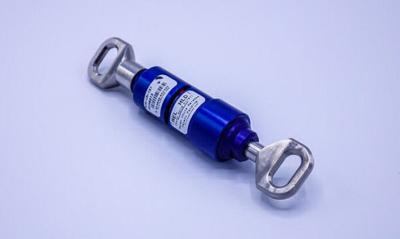Sat, Jan 23, 2021
Launches New On-Landing Parachute Release Device
Fruity Chutes has launched the Raven On-Landing Parachute Release (ROPR), a device that allows a parachute to be automatically released from a payload upon landing.

This mitigates potential damage caused by wind that could otherwise drag a valuable payload after landing. Unlike other on-landing release devices, the Raven On-Landing Parachute Release is designed specifically for UAV and rocketry use and is lightweight, compact, and easy to use.
In order to work reliably, the ROPR has an internal hold timer that assures the parachute will not be released early after initial deployment due to opening bounce or other deployment shocks. The hold timer locks the device while the parachute is opening and unstable. After being under chute in steady descent for between 4 to 6 seconds, the hold timer rotates to allow for release only after landing - when the pull of the parachute unloads. Under no conditions can the parachute release early as long as the main parachute is open and the ROPR remains under load.

This type of device has many applications for situations where having the parachute detach after landing is a huge benefit, such as landing drones, other UAV and rockets. Additional uses include, but are not limited to, water drop payloads such as sonobuoys, where the payload needs to detach after splashdown, and airdrop cargo systems. For people undergoing ASTM flight testing, the ROPR can minimize damage from multiple test flights where wind conditions can damage the drone being tested.
“I’ve personally seen, after landing in windy conditions, valuable high-power rockets get dragged for miles and take on heavy damage,” said Gene Engelgau, CEO of Fruity Chutes. “One time, we had to drive to chase a rocket being dragged, and my son had to tackle the rocket to stop it. I designed the Raven device with the intention of helping others prevent this high-stress situation.” Gene also noted that rockets are more durable than drones and, regardless, take a lot of damage. Drones, being more expensive and fragile, would face even more damage.
More News
With Testing Soon Complete, Launch Preparations Begin in Earnest Sierra Space's Dream Chaser has been put through the wringer at NASA's Glenn Armstrong Test Facility in Ohio, but w>[...]
Takeoff Roll The process whereby an aircraft is aligned with the runway centerline and the aircraft is moving with the intent to take off. For helicopters, this pertains to the act>[...]
“We’re proud of the hard work that went into receiving this validation, and it will be a welcome relief to our customers in the European Union. We couldn’t be mor>[...]
"Aircraft Spruce is pleased to announce the acquisition of the parts distribution operations of Wag-Aero. Wag-Aero was founded in the 1960’s by Dick and Bobbie Wagner in the >[...]
IDENT Feature The special feature in the Air Traffic Control Radar Beacon System (ATCRBS) equipment. It is used to immediately distinguish one displayed beacon target from other be>[...]
 Sierra Space Repositions Dream Chaser for First Mission
Sierra Space Repositions Dream Chaser for First Mission ANN's Daily Aero-Term (05.10.24): Takeoff Roll
ANN's Daily Aero-Term (05.10.24): Takeoff Roll Aero-News: Quote of the Day (05.10.24)
Aero-News: Quote of the Day (05.10.24) Aero-News: Quote of the Day (05.11.24)
Aero-News: Quote of the Day (05.11.24) ANN's Daily Aero-Term (05.11.24): IDENT Feature
ANN's Daily Aero-Term (05.11.24): IDENT Feature




